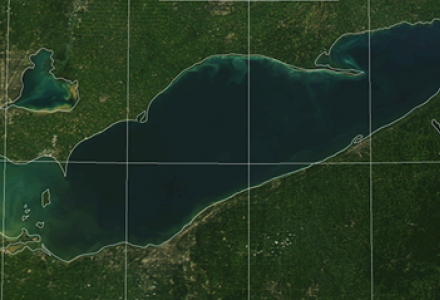
The flow of water from Lake Superior to Lake Huron has been controlled for almost a century through a series of structures on the St. Marys River, which involves work crews turning manual cranks. But now the US Army Corps of Engineers is moving ahead with a project that will set up some gates to be opened and closed with the push of a button.
Control structures on the St. Marys are under the supervision of the International Lake Superior Board of Control, including a 16-gate structure called the Compensating Works. Opening and closing the gates—eight on each side of the international border—allows the board to help control outflows from Lake Superior for hydropower, navigation, riparian, and environmental interests.
The Army Corps project will upgrade operations for at least four of the US gates. This will reduce the amount of effort required to work with the gates, and allow the board to be more responsive to water conditions to help provide better habitat for aquatic species in the St. Marys Rapids, said John Allis, the board’s alternate regulation representative and chief of the Great Lakes Hydraulics and Hydrology Office for the Army Corps Detroit District. When the board is setting the amount of water to release from Lake Superior each month, it needs to allocate enough for municipal and industrial water needs, the Soo Locks used for shipping, and for the rapids’ fish habitat. The remaining water goes to the three hydropower plants on the river. The board has, over the years, gotten a better idea of how best to manage the water to support that fish habitat in the St. Marys Rapids by partially opening more gates by smaller amounts, which in turn has led to more demands on staff to operate the gates with manual cranks.
Since opening and closing gates is currently a labor-intensive process for work crews, it creates practical limits on what kind of gate adjustments are feasible, Allis said. The automated system will make it easier to open and close gates more quickly, and more slowly—which is important to fish and other wildlife in the rapids. The roughly 80-acre St. Marys Rapids, located just downriver from the gates, is a major spawning and feeding ground for a wide range of fish species, including salmon and trout.

“Almost every month in the summer through the fall there’s some species that end up using the rapids for spawning,” Allis explained. “It’s one of the most productive areas on the Great Lakes.”
With the current hand-crank system, however, water levels can fluctuate suddenly and cause major problems for the fish. A sudden loss of water can strand fish, while a sudden burst can wash both fish and their eggs out of the rapids. With automated gates, Allis said the board can instead make slower, more gradual changes by opening gates gradually, improving the productivity of the spawning area. While crews can make those slower adjustments with the current crank system, the number and amount of time required of staff makes it unfeasible on the US side.
The US$8 million project to modernize the four gates would get underway in the spring of 2017 and should be complete by December 2018, with funding from the US Environmental Protection Agency’s Great Lakes Restoration Initiative. The remaining manually operated US gates could be automated as part of the project based on additional funding.
The Army Corps operates and maintains the US gates. Brookfield Renewable Energy Group handles the eight Canadian gates on behalf of the Canadian government, none of which are part of the upgrade project. Allis said the board will leverage the automated gates in concert with the manual gates to make sure fish in the rapids have an ideal amount of water and flow while still retaining flow for other needs.
Allis said the project won’t impact water levels of Lake Superior or Lake Huron, since it doesn’t affect the amount of water coming in from Lake Superior each month. This just provides more flexibility for how to release that water throughout the month, adjusting how the flow moves across the rapids and making more gradual changes. A healthier environment for spawning on the rapids could be beneficial to anglers, he said, and would provide some additional habitat for native species.
“Improving spawning conditions (and fish habitat) in the St. Marys Rapids provides a tremendous regional benefit to the Great Lakes ecosystem,” Allis said.


Kevin Bunch is a writer-communications specialist at the IJC’s US Section office in Washington, D.C.



